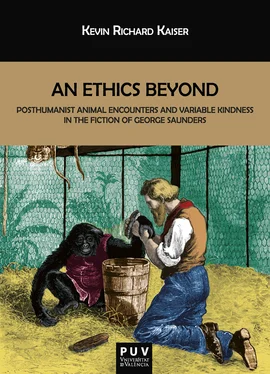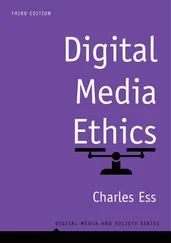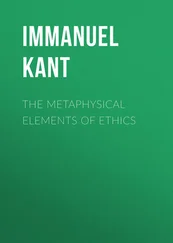Both ontically and ontologically, Western humanism has determined the human by setting it over and against an “Other.” The contemporary conception of the human is a product of a tradition that has sought to hypostatize the human by discriminating “Man” from the Other. We define the (upper-class or bourgeois white male) human 18in terms of what it is not. For Wolfe, posthumanism’s concern focuses on what “comes both before and after humanism: before in the sense that it names the embodiment and embeddedness of the human being” in both its biological world and its technological world and “after in the sense that posthumanism names a historical moment in which the decentering of the human by its imbrication in technical, medical, informatic, and economic networks” can no longer be ignored (WP xv). In other words, posthumanism takes seriously the deanthropocentrizing of humanism.
As Wolfe remarks, a deanthropocentrizing move is not a posthumanist means by which to reject humanism entirely but the application to humanism of “the philosophical and theoretical frameworks used by humanism” so as to radicalize and follow through with humanism’s commitments (WP xvii). His belief is that posthumanism must continue to work through theory rather than abandon theory. The problem, Wolfe claims, is that “Enlightenment rationality is not […] rational enough” in that it “stops short of applying its own protocols and commitments to itself” (WP xx). To put this another way, the procedures and obligations of humanism are not sufficiently utilized—or ever utilized—to address the very system from which they emerge. Humanism, it seems, does not take its own demands for rationality seriously. Wolfe contends that what posthumanism does is apply the protocols and commitments it has inherited from humanism to humanism. What we discover in the process is that whatever it is we call “the human” is not something apart from the other-than-human.
While I agree that humanism has not examined itself according to its own framework, I am not certain that the insinuation that posthumanism should be more rational is how we should think about this predicament. The question is not whether applying the frameworks of humanism to humanism can ever be rational enough—it is about whether it can be radical enough. I do not intend to single out Wolfe here, as I believe his insistence on working through theory as a solution to our posthuman predicament is almost comparable, for example, to Braidotti’s insistence on criticism and creativity in active thinking. However, I do think his insistence on rationality and logic can serve as an example of the problems that can be encountered in articulating posthumanist theory. For this reason, Wolfe’s insistence on rationality and logic—on what can read, out of context, as a decisively humanist approach to posthumanism—should be addressed, accompanied by an understanding of the body’s role in posthumanist theory.
Gender theorists and postcolonial theorists recognize both the importance of what is communicated and how it is communicated. Moreover, they hold accountable a body’s communication—or what Judith Butler and others call “performance”—for both its intended and unintended effects. It is worth explaining then that when Wolfe insists, concerning the institution of speciesism, that “posthumanist theory of the subject has nothing to do with whether you like animals ,” his intention is not to slight, for instance, ecofeminist theory in general (AR 7, italics original). 19His point is that posthumanist theory is not contingent upon whether we like an animal or not, and, therefore, that ethical pluralism cannot be contingent upon species preference, or speciesism. Regardless of the intention, an emphasis on rationality—that Enlightenment rationality is not sufficiently rational—does appear to privilege mind over body, logic as separate from a more bodily responsivity, reinforcing the traditional mind/body binary that gender theorists or ecofeminists might want to undo.
Similarly to posthumanist theory, ecofeminism, according to Mary Phillips, aims to reveal that the cultural hegemony’s ideal of masculinity is fostered “through a set of interrelated dualisms, such as mind/body, reason/nature, reason/emotion, masculine/feminine or human/nature” (2016, 59). The danger here is that in calling for an increase in rationality, the traditional cultural associations are carried along with it. As Phillips notes, “[n]on-conformance with the categories determined by the dominant group, including mind over body, reason over emotion, activity over passivity, is therefore to be considered either an inferior copy of the human, or non-human” (60). Emphasizing rationality can, intentionally or unintentionally, reify the same humanist notion of the human—and the compulsion to transcend body—it rejects.
This is not to suggest that rationality or logic—or theory, for that matter—should be rejected. Rationality and emotion should maintain a balance. In this way, we can stay consistent with new (scientific) approaches to understanding mind and body, rationality and emotion. Furthermore, the decentering of the human cannot mean privileging or rejecting mind or body any more than it can mean continuing to conceive them as distinctly separate attributes in opposition. Thus, although Wolfe works beyond dualisms, the unintended potence of his logic, and that of any posthumanist, must be checked by thinking “outside” the system or field of specialization. Thus, how thinking confronts the topics of posthumanism and how that thinking must evolve is essential. Like Braidotti, Wolfe calls for a posthumanist process of thinking. If posthumanism is concerned with “a thematics of the decentering of the human in relation to other evolutionary, ecological, or technological coordinates,” it is equally concerned with “how thinking confronts that thematics” and what it must become (WP xvi). Wolfe argues that
posthumanism can be defined quite specifically as the necessity for any discourse or critical procedure to take account of the constitutive (and constitutively paradoxical) nature of its own distinctions, forms, and procedures—and take account of them in ways that may be distinguished from the reflection and introspection associated with the critical subject of humanism. The “post” of posthumanism thus marks the space in which the one using those distinctions and forms is not the one who can reflect on their latencies and blind spots while at the same time deploying them. That can only be done […] by another observer, using a different set of distinctions—and that observer […] need not be human (indeed, […] never was “human”). (WP 122)
If Wolfe’s supposition of the role of the “post” in posthumanism, as applied here to humanism, is necessary in order to reflect on “latencies” and “blind sports” then this approach also applies, similarly, to posthumanism itself.
In their essay, “What’s Wrong with Posthumanism?” (2003), Stefan Herbrechter and Ivan Callus call for a critical posthumanism. The concern is “that posthumanism is in the process not so much of being appraised by theory as going along with it. Theory’s strength has always been its claims on the radical, on ‘thinking otherwise,’ on problematizing that which appears commonsensical” (Herbrechter and Callus n.p,). In other words, discourses on posthumanism should be read critically. Theory should “contrive a ‘metaposthumanism,’ with the meta-understood not in the sense of any of the totalizing impulses theory critiques elsewhere […] but according to a signaling of theory’s disposition to step back” and “to cast a sober, evaluative eye over posthumanist orthodoxy” (Herbrechter and Callus n.p.). If posthumanism is to be truly posthumanist, in the senses suggested by Braidotti, Wolfe, Herbrechter, and Callus, posthumanism can never be orthodox. Thinking must remain active.
Читать дальше












